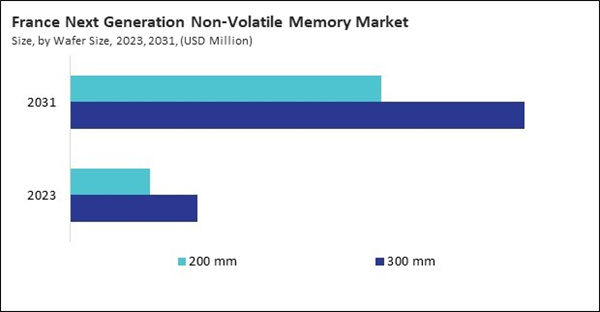The Germany market dominated the Europe Next Generation Non-Volatile Memory Market by Country in 2023, and would continue to be a dominant market till 2031; thereby, achieving a market value of $1.04 billion by 2031. The UK market is capturing a CAGR of 15.8% during 2024-2031. Additionally, the France market would experience a CAGR of 18% during 2024-2031.
ADAS relies on NVMs for storing critical data related to vehicle safety and navigation systems. The non-volatile nature ensures that data such as sensor calibration and mapping information is preserved during power cycles, enhancing vehicle safety and performance. In-car entertainment systems use NVMs to store multimedia content, application data, and system settings. The high-speed access and reliability of NVMs ensure seamless operation and quick access to entertainment features. Automotive telematics and control units benefit from the reliability and data retention capabilities of NVMs. They support remote diagnostics, fleet management, and real-time data processing.
Moreover, next generation NVMs, such as 3D NAND and ReRAM, are used in data centres to provide high-speed storage solutions. These technologies offer increased storage density and faster data access, which is critical for managing large volumes of data and supporting cloud services. In cloud computing environments, NVMs are employed for caching and buffering to speed up data retrieval and processing. Their ability to retain data during power interruptions enhances data integrity and reduces latency.
The rise of digital and mobile banking services in the UK drives the demand for high-performance memory solutions. Next generation NVM enhances the performance and reliability of digital banking platforms and applications. Additionally, the United Kingdom is the foremost fintech centre in Europe. The UK was home to over 3,200 fintechs in 2022, a significant increase from the 3,000 established in 2021. The UK’s investment in fintech and innovative financial technologies fosters the adoption of advanced memory solutions.
Next generation NVM supports fintech applications by providing high-speed, reliable memory for complex financial transactions and applications. Enhancing customer experience through personalized services and faster transaction processing requires advanced memory solutions. Next generation NVM enables faster data retrieval and improved service delivery in the BFSI sector. Therefore, rising BFSI sector and expansion of the IT industry in the region is driving the growth of the market.
List of Key Companies Profiled
- Samsung Electronics Co. Ltd
- Micron Technology, Inc.
- Fujitsu Limited
- Honeywell International, Inc.
- Infineon Technologies AG
- ROHM Co., Ltd.
- Toshiba International Corporation
- Intel Corporation
- Kingston Technology Company, Inc.
- Kioxia Holdings Corporation
Market Report Segmentation
By Type
- High-bandwidth Memory (HBM)
- Hybrid Memory Cube (HMC)
By Wafer Size
- 300 mm
- 200 mm
By Application
- BFSI
- Information Technology
- Consumer Electronics
- Telecommunications
- Government
- Others
By Country
- Germany
- UK
- France
- Russia
- Spain
- Italy
- Rest of Europe
Table of Contents
Companies Mentioned
- Samsung Electronics Co. Ltd
- Micron Technology, Inc.
- Fujitsu Limited
- Honeywell International, Inc.
- Infineon Technologies AG
- ROHM Co., Ltd.
- Toshiba International Corporation
- Intel Corporation
- Kingston Technology Company, Inc.
- Kioxia Holdings Corporation
Methodology

LOADING...









